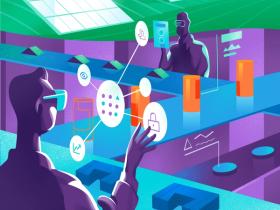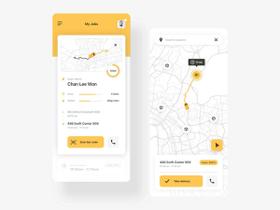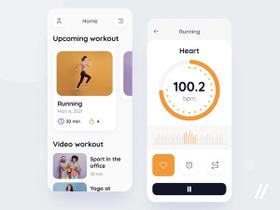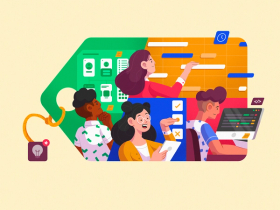How to Build an IoT Application: The Way to Success
Published: November 27, 2023
34 min read
In this article, you'll learn:
1
🗂️ Industries With High Demand for IoT Applications
2
✅ Top Things to Pay Attention to When Developing a Software for Your IoT Device
3
🕳️ Potential Pitfalls & How to Avoid Them
4
☁️ Platforms to Use for IoT Development
5
⚙️ Top Functionality of an IoT Software
6
🤖 How to Integrate an IoT with Third-Party Devices like Google Home & Alexa?
7
💰 What Affects IoT Application Development Costs?
8
👨💻 Our Expertise in IoT App Development
9
💡 Takeaways
Not only “things” get improved but software for their remote control gets diversified as well. In the realm of IoT application development, today's technology allows for customization to specific devices and applications, ranging from smart home solutions to extensive dashboards for larger-scale systems like medical appliances in hospitals and smart agricultural equipment.
If you’d like to learn more about this case or about IoT in the fitness industry, feel free to follow the link at the bottom of this section.
🗂️ Industries With High Demand for IoT Applications
The Internet of Things has permeated various sectors, revolutionizing how we interact with technology and each other. Here's a closer look at the industries where IoT applications are in high demand.
Use Cases in Healthcare
Smart devices have unlocked a new realm for patients' safety and health, equipping doctors to provide superior care, highlighting the significance of app development for healthcare, particularly in building tailored IoT applications. The deployment of diverse hardware such as wearables, sensors, and scales has facilitated meticulous monitoring, granting doctors the lead time to implement preventive measures and render accurate diagnoses.
Examples of IoT Apps in Healthcare
Smartwatches, a prominent example of IoT in the fitness industry, such as the Apple Watch, have capabilities to monitor heart rates continuously. This feature is not just for fitness tracking; it has the potential to detect heart conditions and prevent heart attacks by monitoring for signs like blood clot formation. In addition, Apple has introduced an API for its watches that focuses on monitoring Parkinson’s disease. This technology facilitates the automatic tracking of symptoms such as tremors and dyskinesia, which traditionally required diagnostic tests and symptom diaries under a physician's supervision.
CenTrak's RTLS aims to enhance the healthcare environment by providing precise location data and analytics. This system helps healthcare organizations improve the overall patient experience, optimize the workflow of medical staff, and manage the use and availability of medical equipment effectively.
Use Cases in Logistics
t's not just about tracking objects - real-time data collection and transfer capabilities revolutionize asset transportation, underscoring the importance of learning how to make an IoT app for efficient logistics management. IoT applications can remotely manage transport elements, optimizing energy use and enhancing customer experiences by minimizing wait times.
Examples of IoT Apps in Logistics
In the realm of internet of things application development, solutions like Zubie serve the logistics industry by providing a comprehensive fleet management solution. The primary goal of Zubie is to enhance the efficiency of business operations by offering robust vehicle tracking, maintenance alerts, and driver safety insights.
DHL has integrated advanced technologies into its trucks to improve efficiency, service quality, and real-time tracking capabilities. This includes the use of sensors and connected devices that monitor various aspects of the delivery process, such as vehicle location, temperature control for sensitive shipments, and optimal routing to reduce transit times and fuel consumption.
Use Cases in Automotive
The term "Automotive IoT" encapsulates the fusion of IoT components within vehicles, transforming them into hubs of connectivity and intelligence. This encompasses everything from car connectivity and predictive maintenance to comprehensive fleet management.
Examples of IoT Apps in Automotive
Tesla mobile application allows Tesla owners to remotely monitor and control various aspects of their vehicles, such as checking the charge level, starting the car, pre-conditioning the temperature, and locating the vehicle. Among similar applications: BMW ConnectedDrive, FordPass, Volvo Cars app, myAudi.
ChargePoint it's an app for electric vehicle users that provides access to a network of charging stations, allowing users to find available stations, start charging sessions, and track usage.
Use Cases in Smart Homes
Home automation through IoT-enabled devices and systems allows homeowners to command their domestic appliances with ease. This extends from intricate heating and lighting systems to remote-controlled security measures. By harnessing the power of IoT, homeowners gain control over their living spaces, enabling them to conserve resources and reduce expenses by closely monitoring and managing energy and water usage.
Examples of IoT Apps in Smart Homes
In smart home app development, systems like Philips Hue exemplify how users can control light settings, color, and intensity remotely via a mobile app, integrating with other smart home devices for automated routines.
Google Nest offers various options for Ayoti devices for your home: speakers, smoke & CO alarms, door locks, cameras, doorbells, and thermostats.
In Internet of Things application development, choosing the right IoT protocol is crucial for your project's success. Don't leave it to chance. Discuss your needs with our specialists who understand the nuances of IoT connectivity. Get in Touch and we'll help you select the ideal option!
🕳️ Potential Pitfalls & How to Avoid Them
When an IoT development company is creating an application for your IoT device, it is crucial to be aware of possible nuances that can negatively impact costs, user experience quality, or development speed if not properly addressed.
So, let’s briefly review the main pitfalls that can await you during development.
# 1: Firmware
As we have already discussed, firmware enables the communication between different parts of your hardware.
What’s important here is that the development speed directly depends on whether or not your firmware is ready-to-use.
Encountering challenges in IoT development? Our team at Stormotion is here to navigate you through the complexities. Connect with us for an in-depth consultation and ensure your IoT project is on the path to success.
☁️ Platforms to Use for IoT Development
So that the IoT development is a little easier, there are various platforms on the market that you can use: ready-to-use sets of features and tools. Their functionalities cover various needs such as connectivity, data flow, app functionality, etc.
⚙️ Top Functionality of an IoT Software
In this section, we’ll review the main components of IoT software (which can be developed as a mobile app, website, dashboard, etc.) services that a user might need.
However, we’d like to draw your attention not to the feature itself but to certain nuances and not-so-obvious aspects that there may be.
# 1: Data Collection 📥
The backend of your software is responsible for data collection and, in fact, there are multiple ways of how you can organize it, which can save you energy, resources, and money if chosen correctly.
🤖 How to Integrate an IoT with Third-Party Devices like Google Home & Alexa?
When such virtual AI (artificial intelligence) assistants entered the market, it became truly disrupted. Nevertheless, the good news is that you can integrate your IoT device with them to provide additional value to your users.
💰 What Affects IoT Application Development Costs?
When planning out your IoT application development costs, it’s important to make sure that your budget is big enough, but while the exact numbers can’t be predicted since each case is unique, there are a couple of features that you and your development team might consider during your calculations.
👨💻 Our Expertise in IoT App Development
We at Stormotion have leveraged our expertise in IoT to develop applications that enhance the interaction between users and their devices, ensuring a seamless and intuitive experience. Here's a look at how we approached and executed projects for Norsk, SportPlus, and Stepr.
For Norsk, we took on the challenge of transforming their existing application into a sophisticated companion app for their series of batteries. Our team developed and integrated a communication protocol that enabled Bluetooth Low Energy (BLE) connectivity between the batteries and the application. This protocol was crucial in allowing the app to monitor and manage the battery status, ensuring safety during open water, ice fishing, and kayaking activities.
Also, we’ve worked with Stepr. In collaboration with them, we developed an Android-based tablet application that communicates with the fitness device through a Serial connection, granting users full control over the equipment. Our role included integrating a protocol from a Chinese partner and developing the application to facilitate the device's market launch.
💡 Takeaways
As you can see, the process of IoT app development has quite a few pitfalls, needs to be well thought out and in advance, and requires much technical knowledge.
However, the game is worth the candle since the market is relatively new, and most new “things” thrill the industry, allowing you to gain greater profits.
Keep in mind, your specific use case defines many things during the development. Surely, we can give you general advice and prevent you from making certain mistakes based on our experience. Eventually though, your preferences & needs will be the decisive factor in many cases.
If you need any help with the development or have any questions left, feel free to reach out to us. We’ll find a way to help you!
Was it helpful?
Questions you may have
Take a look at how we solve challenges to meet project requirements
What is an IoT application, and how does it work?
An IoT application is a software application that is part of the Internet of Things (IoT) ecosystem. It typically involves a network of physical objects ("things") embedded with sensors, software, and other technologies to connect and exchange data with other devices and systems over the internet. These applications enable the collection, exchange, and analysis of data, often facilitating automation and improved efficiency.
What programming languages are commonly used to develop IoT applications?
The programming languages used for IoT applications vary depending on the component being developed. For device-level programming, C and C++ are commonly used due to their efficiency and control over system resources. For higher-level IoT applications, languages like Java, Python, JavaScript, and Go are popular choices.
What type of devices can be integrated into an IoT application?
A wide range of devices can be integrated into an IoT application, including but not limited to sensors, actuators, smart appliances, wearable devices, medical devices, and industrial machinery.
How do I choose the right IoT platform for my application?
Choosing the right IoT platform involves considering factors such as the supported data and network protocols, cloud architecture flexibility, scalability, hardware support, security mechanisms, and the ability to integrate with other systems.
What are some common challenges when developing IoT applications?
Common challenges include ensuring interoperability among diverse devices and systems, managing the security and privacy of data, achieving scalability, and handling the complexity of developing and maintaining an ecosystem of interconnected devices.
How can I ensure my IoT application is secure?
To ensure security, implement strong user authentication, data encryption, access rights management, and comply with security standards like ISO27001, SOC2 Type 2, and IEC 62304 for healthcare-related apps. It's also important to use secure connections (HTTPS) and consider security from the start of the development process.
How can I test my IoT application?
Testing an IoT application involves various types of testing such as security, performance, usability, compatibility, and scalability testing. Specific IoT testing tools like Wireshark or mPulse can be used to facilitate this process.
What are some best practices for developing IoT applications?
Best practices include focusing on user experience, employing a multi-layered security approach, using third-party SDKs and APIs to speed up development, prioritizing back-end and API development, and incorporating automated testing throughout the development process.
How can I optimize the performance of my IoT application?
Performance optimization can be achieved by efficient use of resources at the device level, optimizing data transmission, using edge computing to process data closer to the source, and employing scalable cloud services.
What resources are available to help me develop my IoT application?
Resources for developing IoT applications include open-source platforms like Thinger.io, commercial IoT platforms like Kaa IoT Platform, and services offered by tech giants such as Amazon, Microsoft, and Google. Additionally, there are numerous development frameworks, libraries, and tools available to assist in the development process.
Read also

What is Prototyping in IoT and Some Practical Advice

What is IoT Monitoring?

What is IoT Device Management?

IoT in Logistics & Transportation

IoT in Healthcare: From Clinics to Mobile Apps

IoT in the Fitness Industry: Devices, Use Cases & Tips

How Much Does It Cost to Develop an IoT Application: A Case Study-Based Roadmap
Our clients say
![Stormotion client Pietro Saccomani, Founder from [object Object]](/static/40e913b6c17071a400d1a1c693a17319/b0e74/pietro.png)
They make the whole business work for us, and their improvements are fundamental to our operations. They’re reliable, honest, and willing to try new things that will help us. We appreciate how flexible and easygoing they are.
Pietro Saccomani, Founder
MobiLoud
